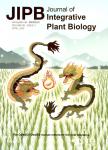Cytokinin levels and signaling respond to wounding and the perception of herbivore elicitors in Nicotiana attenuata
Cytokinin levels and signaling respond to wounding and the perception of herbivore elicitors in Nicotiana attenuata作者机构:Department of Molecular Ecology Max Planck Institute for Chemical Ecology Laboratory of Hormonal Regulations in Plants Institute of Experimental Botany AS CR German Centre for integrative Biodiversity Research (i Div)
出 版 物:《Journal of Integrative Plant Biology》 (植物学报(英文版))
年 卷 期:2015年第57卷第2期
页 面:198-212页
核心收录:
学科分类:0710[理学-生物学] 071001[理学-植物学] 07[理学] 09[农学] 0904[农学-植物保护] 0901[农学-作物学] 0703[理学-化学] 090401[农学-植物病理学] 0902[农学-园艺学] 090402[农学-农业昆虫与害虫防治]
基 金:funded by the Max-Planck-Society, Meza-Canales by the DAAD Vanková by the Czech Science Foundation, project no. 206/09/2062 Meldau and Brütting are funded by Advanced Grant no. 293926 of the European Research Council to Baldwin
主 题:Arabidopsis thaliana cytokinin herbivore-associated molecular patterns herbivory insect jasmonic acid Manduca sexta Nicotiana attenuata wounding
摘 要:Nearly half a century ago insect herbivores were found to induce the formation of green islands by manipulating cytokinin (CK) levels. However, the response of the CK pathway to attack by chewing insect herbivores remains unclear. Here, we characterize the CK pathway of Nicotiana attenuata (Torr. ex S. Wats.) and its response to wounding and perception of herbivoreassociated molecular patterns (HAMPs). We identified 44 genes involved in CK biosynthesis, inactivation, degradation, and signaling. Leaf wounding rapidly induced transcriptional changes in multiple genes throughout the pathway, as well as in the levels of CKs, including isopentenyladenosine and cis-zeatin riboside; perception of HAMPs present in the oral secretions (OS) of the specialist herbivore Manduca sexta amplified these responses. The jasmonate pathway, which triggers many herbivore-induced processes, was not required for these HAMP-triggered changes, but rather suppressed the CK responses. Interestingly CK pathway changes were observed also in systemic leaves in response to wounding and OS application indicating a role of CKs in mediating long distance systemic processes in response to herbivory. Since wounding and grasshopper OS elicited similar accumulations of CKs in Arabidopsis thaliana L., we propose that CKs are integral components of wounding and HAMP-triggered responses in many plant species.



